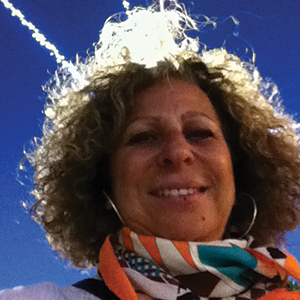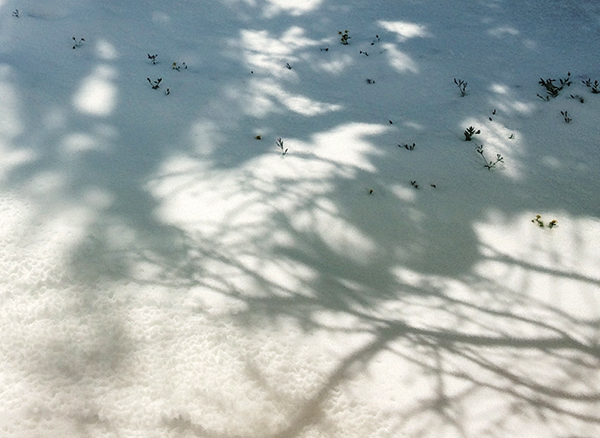
Sufism is about the path of spiritual advancement, a process of purification. It enlightens the inner being, which makes it a natural antidote to fanaticism. Sufism is often defined by scholars as the mystical dimension of Islam or “the school of the actualization of divine ethics.” Sufi practices allow light to enter to our hearts, and much more.
The practice of Sufism includes meditation, ziker, poetry, and wisdom, and all of these have to do with ethics. People who practice Sufism are those who seek the truth, who, by means of love and devotion, move towards the truth. Sufism mentions Plato, Aristotle, Murcia, Ibn Rushd, Al-Ghazali, Al-Rumi, Ibn Arabi, and many others. When we talk about Sufism, terms such as tariqa, zawiya, khanqah, and ribat are mentioned. Sufism is the spiritual path or way towards God.
Once upon a time, a long time ago, when we were kids, some of us were privileged to belong to the different youth clubs of the Jerusalem YWCA. One early morning between winter and spring, we took off on a day trip to Wadi Qelt. The bus stopped near St. George’s Monastery, which we saw from a hilltop. We started to hike. It was a very long way. We walked on the high ledges of water canals, hardly looking down, trying not to fall. We moved forward impatiently, seeking to reach our destination. As kids, we were proud to take such a dangerous road. We discovered caves, walked deeper into the gigantic rocky hills, and met the ancient monks who lived there. I had a feeling like sea waves moving inside my own body that took me back and forth within my inner self, calming my mind and soothing my soul. Today, when I watch the red cable cars carrying people to visit the Greek Orthodox monks living inside Mt. Temptation, this feeling comes to me and I tell myself, this must be a moment of spirituality!
“This is where we used to picnic every year during spring time. Take a quick look.” My mother would point towards a line of white domes in the mountains, amidst the Jordan Valley landscape between Jerusalem and Jericho. Mother’s childhood memories were full of joy, and she repeated to us, “At Nabi Musa, we colored eggs just like during Easter.” The site is a maqam, with a tomb made of a stone covered with green cloth with Islamic writing on it. When I was older, my friend Musa told me, “You don’t have to feel anything here. Moses (Musa), you know, never reached Palestine.” However, Nabi Musa is a magnificent Sufi site, which goes back to the Ayyubids. Baybers, the Mamluk leader, ordered its construction. Later, the Ottomans added their mark to the site. Despite the contested issue of whether Prophet Moses is lying inside the tomb or never reached Palestine at all, the site remains a spiritual inspiration.
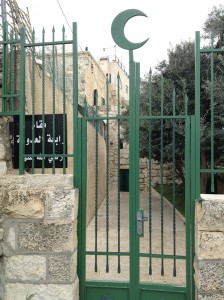
In his book, Al-Dou’al Azraq (the blue light), Hussein Barghouti refers to Palestine as the country of caves, and in Palestinian Walks, Raja Shehadeh mentions Palestinian towns and villages with hidden heritage. Palestine has not only spiritual stones and shrines, but also flora and fauna on its hillsides. Before we reach the Old City of Jerusalem to find out how deep the presence of Sufism is engraved in Palestine, allow me a short stop to propose a Sufi zawiya. A particular, zawiya located on the Mount of Olives in Jerusalem, around the corner from the former Intercontinental Hotel with its seven arches, is a maqam of a great Sufi Woman who was born in the Iraqi city of Al-Basrah. She crossed the desert to reach Jerusalem, or Al Quds, 600 years ago. Whether the maqam contains the physical body of this unique woman or not (a fact which is contested), the site carries her name Rabaa’ Al-Adawiya’.
A Sufi, poet, singer, and mystic, Rabaa’ was born in Al-Basra in 713 AD (100 Hijri). Much of her early life was described by Farid Edine Attar, a Sufi saint and poet of the eighth century. Rabaa’ was the fourth daughter in her family, and therefore, her name means the fourth. Rabaa’ suffered through poverty and later slavery. She was very pretty and had a beautiful voice, so many were competing to possess her. She challenged abuse throughout her adolescence, and overcame all odds to free herself from oppression. Rabaa’ was liberated when the man who bought her saw light (nour) around her one evening while she was kneeling in prayer. Rabaa’ spent most of her life in Iraq then moved to Eygpt, then Medina, and then to Palestine.
Like the one on the Mount of Olives, many streets in Arab cities carry her name, such as the square that became a landmark for the Arab Spring in Cairo. Rabaa’ spent a long period of her life crossing the desert seeking faith and peace. She refused to get married to allow herself to completely indulge in her spiritual love for God. She lived in admiration and worship, or tasawof. Rabaa’ wrote poems describing her love, the reason why she couldn’t get married, and how she finds comfort and relief when by herself. Her spiritual love was referred to as adoration, in Arabic ‘ashq.
Mufid Darwish Al-Alami is the custodian of Rabaa’ Al-Adawiya’s maqam on the Mount of Olives. When I asked him whether Rabaa’ actually lies in the tomb, he replied that Mujeer Eddin in his book Al-Uns Al-Jaleel wrote about Rabaa’ visiting Jerusalem, so it must be true. Al-Maqdisee and Al-Soyouty, both distinguished historians, also wrote about her visit to Jerusalem.
Unlike many saints buried in the Mamilla (Ma’manillah) cemetery whose skeletons have been erased or displaced by the Wiesenthal Museum and the municipality, the tomb of Rabaa’ Al-Adawiya is untouched and protected until today, thanks to the Alami family of Jerusalem. From what I discovered, few people visit the tomb of Sitna Rabaa’. Some neighbors residing around the Al-Alami Mosque, under which Rabaa’ lies, feel proud to be close to such a woman saint; others ignore the name and the site.
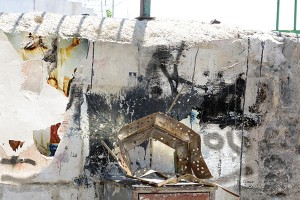
So Palestine, from Safad to Hebron, boasts a number of Sufi zawiyas from the eras of the Ayyubids, the Mamluks, and the Ottomans, which were constructed by Sufi sheikhs, sultans, or leaders. Many of these shrines are located around Al-Aqsa Mosque. Others are found in the Old City. On the way to the Via Dolorosa, one passes by St. Anne’s Church, Bab Faysal, and Tareeq Al-Mujahideen. Just opposite the entrance of Ecco Homo or the Notre Dame de Sion school, lies Al-Naqshabandyeh’ Zawiya, a Sufi tareeq, which represents a major order with a spiritual lineage going back to the to the first Khalifa, Abu Baker Al-Sideeq. The order was founded by Baha Eddine Naqshaband (1318-1389) of Turkestan. Today the Bukhary, descendants of Baha’ Eddine Bukhary, who came from Uzbakistan, live in the house on top of the mosque. Dina, a Sufi friend, would stay at Al-Naqshabandyeh for her annual tasawof in Jerusalem. Around the corner from the Armenian Hospice on the Via Dolorosa, is Tareeq Barqouq, a fifteenth-century zawiya where Sufi rituals are led by Sheikh Abdel Kareem Al-Afaghany of Al-Qadyryah, also known as Al-Afaghanyah. A few steps lower towards Tareeq Al-Wad and Bab Al-Nather of Al-Aqsa Mosque lies Al-Ribat Al-Mansoury, which takes its name from Sultan Al-Mansour Qalawoon, a Mamlouk sultan who followed Sultan Babybers.
Sufi zawiyas located outside the Old City walls include Al-Zawiya Al-Adhamyah located between Damascus Gate and Herod’s Gate and Al-Jarrahyah, from the time of Salahadin Al-Ayubi, which lies in Sheikh Jarrah (next to the American Colony); All these zawiyas, mosques, or schools, which are constructed with different architectural styles, housed people who gathered to meditate and practice Sufism, ‘tasawwof.
“Devotional practice has nothing to do
with rosary, prayer rug or robe;
The true practices of devotion
is but serving others.”
– Rumi
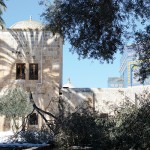
During his first visit to Jerusalem in 2005, Abdel Wahhab Meddeb, author of La Maladie de L’Islam and Phantasia, observed that Jerusalem had a fundamentalist appearance. I started worrying that I was blind to reality. In 2013, when Meddeb came to launch his book on the link between Judaism and Arabism, he was walking in the Old City one evening when he came across a group of people reciting ziker. He was wholly moved and so naturally found himself moving towards the Sufi mosque. This time, the way he described this spiritual experience comforted me about Jerusalem and its people. It suggested they are still able to occasionally offer some peacefulness and love.
Like the Moroccan city of Fez, a spiritual festival of Sufi music and Gnawa is organized every year during the month of May. The Holy Land, and I mean Palestine, has several hidden treasures that tour operators in coordination with archeologists and historians ought to reveal. Yes, Al-Aqsa and the Church of the Holy Sepulcher are the main attractions, however, let’s share and learn about other treasures, like the art of spirituality. Sufism is one of those treasures in our country.
Spiritual tourism, like alternative tourism, can boost the Palestinian economy. Spiritual festivals with poetry, ziker, darawich, trance dance, meditation, and a mix of multicultural Sufi rituals derived from Turkey, Syria, Iraq, and Egypt can create a new concept of tourism. We can invite our own children and youth to explore, like Alice in Wonderland, their own inspiring identity.
Today, as the world increasingly sees Islam wearing a rather repressed and prudish outfit, speaking about Sufism allows what’s left of human beings a spiritual tareeq, or a path to breathe.
» Huda Farid Jamal Imamis, a Palestinian woman, was born and lives in Jerusalem. Huda studied in Jerusalem and in Paris, and in ‘98 got her MBA from the London School of Economics. She is the founder of the Center for Jerusalem Studies in the Old City (Al Quds University), and co-founder of several cultural institutions. For the past decade, Huda’s main work has been to preserve and revive cultural heritage sites and life in Jerusalem, such as Hammam Al-Ayn, Sufi tareeqs, libraries, and, currently, the Pool of the Patriarchs.
Article photos by: Hani Amra.

